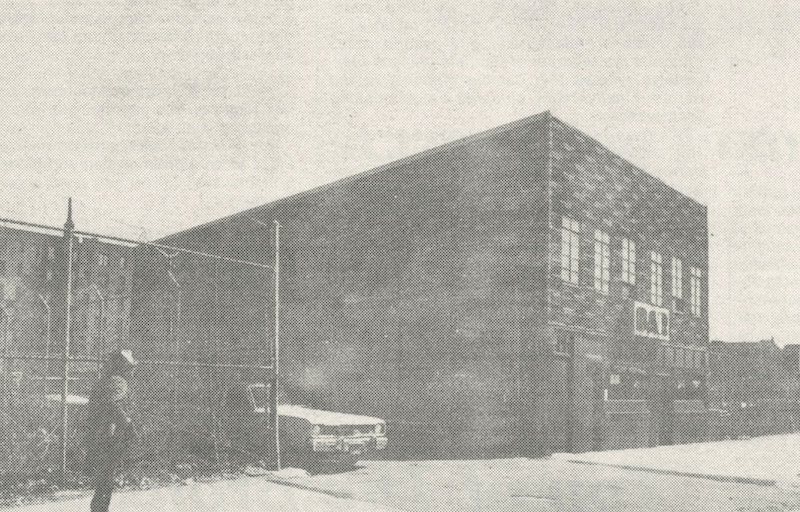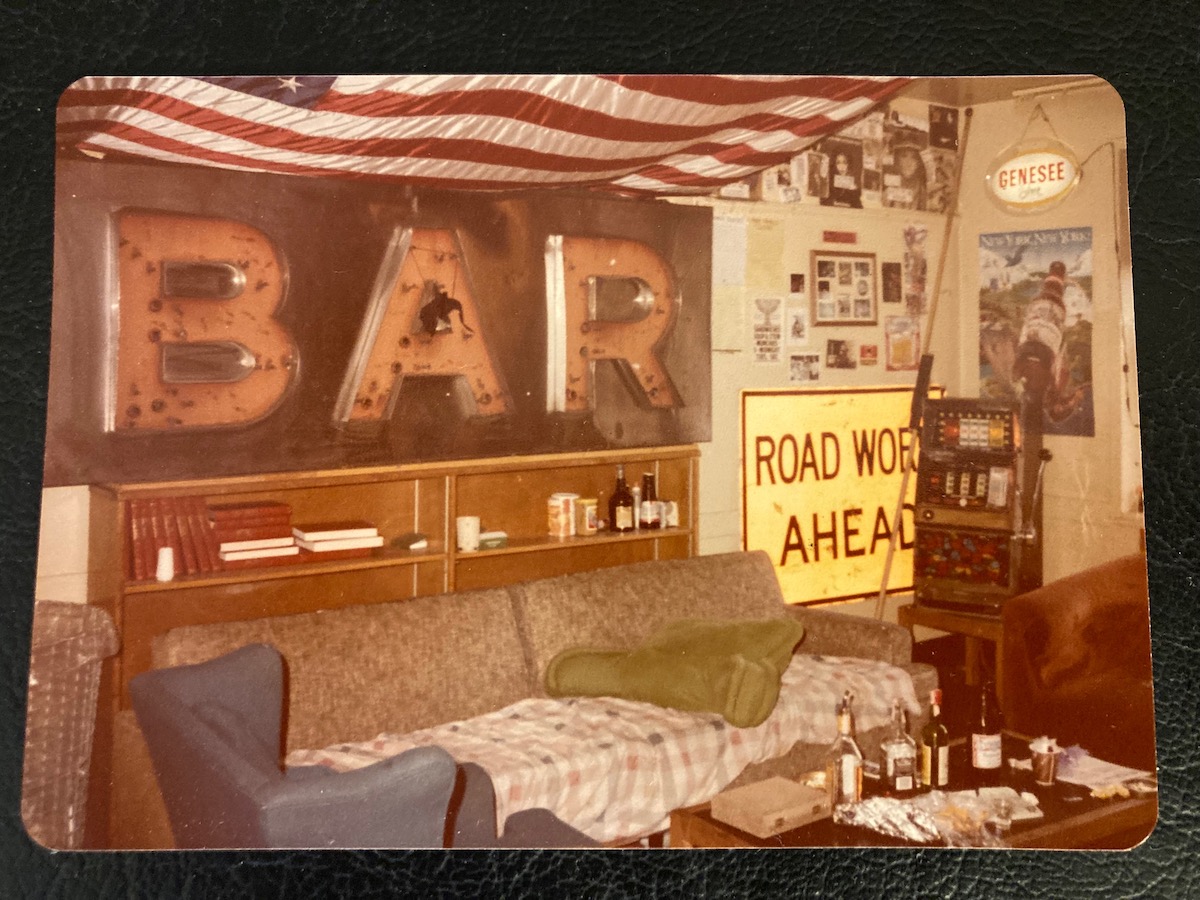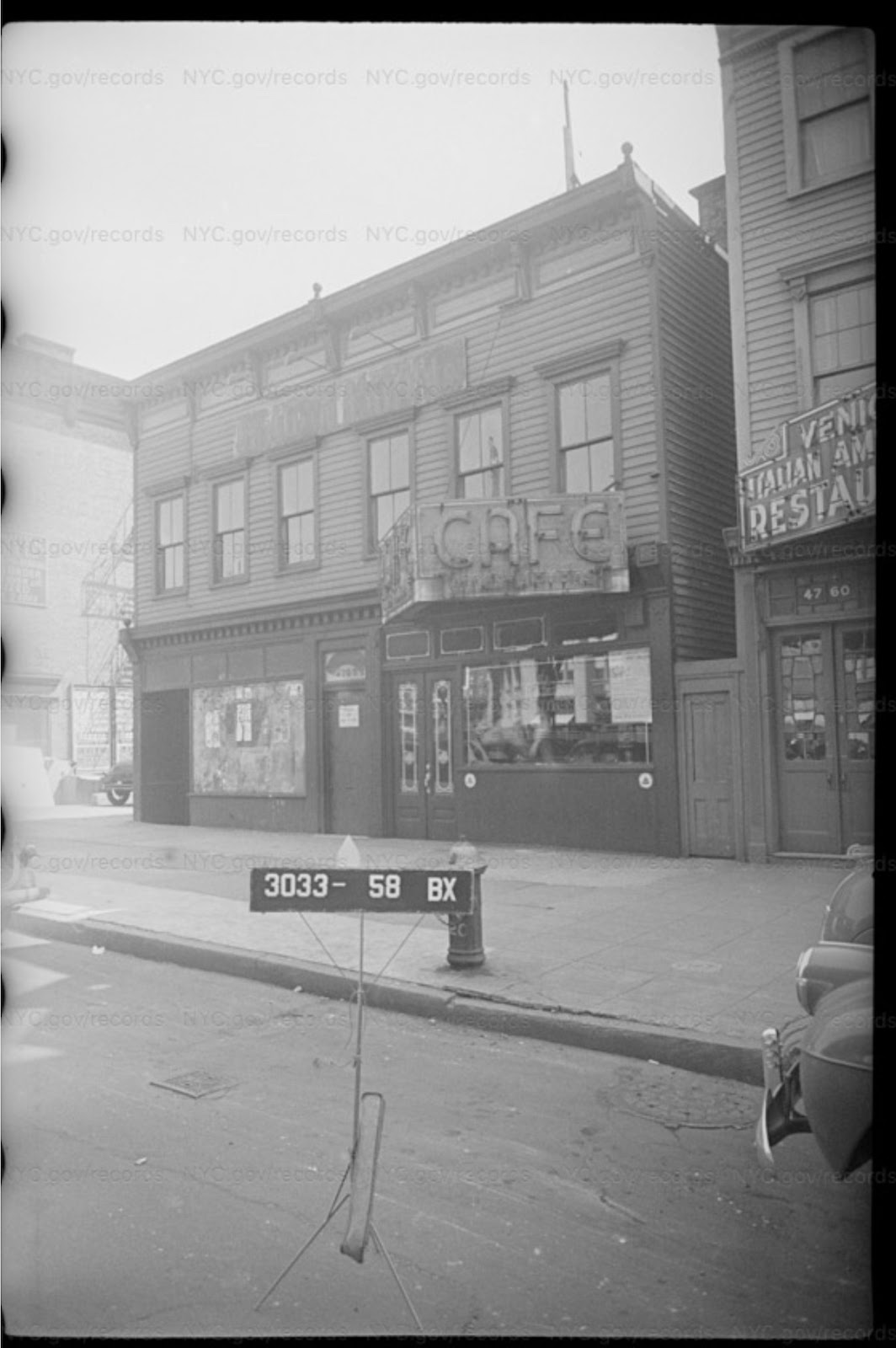“Soon I had acquired a whole constituency of regular customers”: Fred Kimmerly recounts what happened when, as a toll collector on Connecticut’s Merritt Parkway, he began giving out M&M’s.
Monday, August 3, 2009
Mysteries of the tollbooth
In a comment last month, I wrote that the streetside green boxes where United States Postal Service stores mail are “mysterious in the way that, say, a tollbooth’s interior is mysterious — most people haven’t seen what’s in there.”
I did some searching yesterday, and I stand by my analogy, having failed to find a single photograph revealing a tollbooth’s interior. The Life Photo Archive comes close — but the man talking on the telephone in this photograph is a chief, not a toll collector, and the photograph doesn’t reveal the booth’s contents, at least not to my satisfaction.
The mysteries here are ultra mundane, I know. But still I wondered: What’s the floor like? Is there a pad to ease standing? A step on which to rest one leg? In what sort of chair do sitting toll collectors sit? Is there heat? A clock? What keeps the booth from filling with exhaust fumes? And where, while I’m at it, where do the ducks go when the lagoon in Central Park freezes?
Via Google Book Search, I found answers to some of these questions on page 35 of Albert E. Schaufler's Toll Plaza Design (Washington, D.C.: National Academy Press, 1997). Three excerpts:
Booths typically are framed with a plate/rolled steel, stainless steel, or aluminum exterior and interior skin. Most walls are insulated. Most booths are equipped with electric under-the-counter heaters or hot water units. Air conditioning units are distributed equally between booth-mounted units and central systems. . . . Of 21 facilities that reported use of positive ventilation systems (systems that provide pressurized air to a booth to prevent contaminated air from being drawn into the booth), 15 draw fresh air from a remote location. . . .I hope that you found yourself uttering the occasional ah or huh while reading these excerpts. Electric under-the-counter heaters: ah. Toilets: huh.
The booth floor usually consists of concrete poured after the booth is installed in the toll island, covered by a rubber mat to cushion the hard surface, serve as a static protector, and reduce dampness. . . .
In some instances, unusual fixtures or furnishings can be found in booths such as chairs, portable TVs, toilets, sinks, and refrigerators. These booths are generally single-attendant facilities with no utility building. Such a booth, therefore, is sized and equipped to be a “toll house” rather than a toll booth.
As you may already suspect, Toll Plaza Design does not provide a photograph of a tollbooth interior, much less a photograph of “unusual fixtures or furnishings.” No — all that the book offers is Figure 20, "Typical single-ended toll booth (for collection in one direction of travel)":

[Click for a larger view.]
The veil remains unparted.
By
Michael Leddy
at
9:09 AM
comments: 0
![]()
Saturday, August 1, 2009
Irritating
On the New York Times’ online front page:
A man with a fake bomb hidden in a bag tried to board a flight at La Guardia Airport’s central terminal, crippling operations for hours and irritating vacationers.Irritating? Other participles seem more apt. But take a look at Merriam-Webster’s discussion of irritate and related words.
By
Michael Leddy
at
1:49 PM
comments: 0
![]()
Mark Trail channels Dante

Nel mezzo del cammin di nostra vita
mi ritrovai per una selva oscura
ché la diritta via era smarrita.
I should read Mark Trail more often.
A related post
When comics collide
By
Michael Leddy
at
8:33 AM
comments: 0
![]()
Blogger search broken
See the search box at the top left? It’s now broken, at least for many Blogger blogs. Results are often spotty and sometimes non-existent. The problem has become a known issue.
Until the problem’s fixed, you can search a Blogger blog by doing a Google site search, like so:
site:mleddy.blogspot.com keyword keywordYou can search for individual words or for phrases in quotation marks, as with any Google search.
By
Michael Leddy
at
8:12 AM
comments: 11
![]()
Friday, July 31, 2009
Cooking and television
Michael Pollan:
Maybe the reason we like to watch cooking on TV is that there are things about cooking we miss. We might not feel we have the time or the energy to do it ourselves every day, yet we’re not prepared to see it disappear from our lives entirely. Why? Perhaps because cooking — unlike sewing or darning socks — is an activity that strikes a deep emotional chord in us, one that might even go to the heart of our identity as human beings.I’m happy to be part of a family in which everybody cooks.
Out of the Kitchen, Onto the Couch (New York Times)
By
Michael Leddy
at
10:56 AM
comments: 4
![]()
“An Accident of Time and Place”
Sergeant Crowley and I, through an accident of time and place, have been cast together, inextricably, as characters — as metaphors, really — in a thousand narratives about race over which he and I have absolutely no control. Narratives about race are as old as the founding of this great Republic itself, but these new ones have unfolded precisely when Americans signaled to the world our country’s great progress by overcoming centuries of habit and fear, and electing an African American as President. It is incumbent upon Sergeant Crowley and me to utilize the great opportunity that fate has given us to foster greater sympathy among the American public for the daily perils of policing on the one hand, and for the genuine fears of racial profiling on the other hand.Well said. Read it all:
Henry Louis Gates, Jr., An Accident of Time and Place (The Root)
By
Michael Leddy
at
8:02 AM
comments: 0
![]()
Nabokov’s index cards, coming in November
From a Publishers Weekly advance review of Vladimir Nabokov’s The Original of Laura, coming in November:
Nabokov’s handwritten index cards are reproduced with a transcription below of each card’s contents, generally less than a paragraph. The scanned index cards (perforated so they can be removed from the book) are what make this book an amazing document; they reveal Nabokov’s neat handwriting (a mix of cursive and print) and his own edits to the text: some lines are blacked out with scribbles, others simply crossed out. Words are inserted, typesetting notes (“no quotes”) and copyedit symbols pepper the writing, and the reverse of many cards bears a wobbly X. Depending on the reader’s eye, the final card in the book is either haunting or the great writer’s final sly wink: it’s a list of synonyms for “efface” — expunge, erase, delete, rub out, wipe out and, finally, obliterate.Related posts
Nabokov’s unfinished (On The Original of Laura)
Vladimir Nabokov's index cards
By
Michael Leddy
at
7:32 AM
comments: 0
![]()
Understocked
From xkcd: “Actually, it seems we’re out of beer.”
By
Michael Leddy
at
7:00 AM
comments: 5
![]()
Nick DeMaio and the Eldorado
A Bronx tale, of Fordham University and environs:
[T]he one nostalgic oasis of civility in the neighborhood was the old Eldorado Bar on Third Avenue, right under the Third Avenue El. The El was scheduled for demolition by 1972. The bar, which had been a tavern since 1890, had a high, plank ceiling supported by a row of wooden posts, with the big rotating fans that later became fashionable in Manhattan watering holes. It had a pool table with a ripped felt cover, and it served Italian hero sandwiches and hamburgers thrown together in a dingy kitchen in the back. The proprietor was Nick DeMaio, five-foot-six and stocky, in his late seventies, wearing a tie and sometimes an apron. He muttered unintelligible wisdom in a gruff voice with a cigar butt stuck in the side of his mouth.I’m happy to know something about the Eldorado, or the El D, as it was called, a bar I visited but once, with two friends, in the summer of 1981. The place was vast, like an empty stage, with a dull, smooth wood floor. The only people were my friends and I, some tough customers at the pool table, and the proprietor, a little old man wearing a white shirt, a black tie, a brown cigar, and a barkeeper’s apron. The guy was a throwback, as my daughter Rachel would say. He must have been Nick DeMaio.
Nick had bought the place in 1922. Faking it as a flower shop in front, the place had been a speakeasy during Prohibition, but more than anything, with its long, solid mahogany bar and the mirror behind it, it resembled a saloon in the cowboy movies.
Raymond A. Schroth, Fordham: A History and Memoir (Chicago: Loyola Press, 2002), 326.
The Social Security Death Index lists one Nicholas DeMaio whose dates (1898–1993) and last residence (in the Bronx, just a short ride from the bar) mark him as the proprietor of the El D. I’m amazed to think that I was
*
May 20, 2020: A Fordham alum left a link to a 1981 Ram article about Nick DeMaio and the El D. Thanks!
*
May 21: Another alum found a 1978 Ram article with a photo of Nick DeMaio. Thanks!
*
May 22: Here are photographs of the Eldorado and Nick DeMaio, from The Ram, April 20, 1978. The photographer’s name is Joe Spinosa. And now I can say with certainty that that was Nick DeMaio behind the bar.

 [Click either image for a larger view.]
[Click either image for a larger view.]
And one more from The Ram, September 24, 1981. The photographer’s name is Dean Donahue.
 [Click for a larger view.]
[Click for a larger view.]These scans of newspaper pages replace less distinct images from the online Ram. Many thanks to Jeannie Hoag, Reference & Assessment Librarian, and Vivian Shen, Archives Librarian, both of Fordham University.
*
January 29, 2022: And here is a photograph of the El D BAR sign, salvaged by students after the building was razed.
 [Click for a larger view.]
[Click for a larger view.]*
January 31: Three more photographs, with the El D making cameo appearances, to the right of the Third Avenue El, or what then remained of the El. Look for the building with the slanting roof and the two-tone wall: 1, 2, 3.
*
And one more.
*
February 1: And now, at long last, the Eldorado is ready for its close-up:
 [4762 Third Avenue, Bronx, New York, c. 1939–1941. From the NYC Municipal Archives Collections. Click for a much larger view.]
[4762 Third Avenue, Bronx, New York, c. 1939–1941. From the NYC Municipal Archives Collections. Click for a much larger view.]I tried tracking down a tax photograph by checking the 1940 telephone directory, which had no listing for the Eldorado. Without a street address, the bar cannot be found via Street View of 1940s New York, as its address no longer exists (what was 4762 is now part of the massive Fordham Plaza). But if you have a street address to type in, you’ll find the Eldorado in Street View or in the Municipal Archives (albeit as 4764).
Credit for finding the 4762 address (in a 1974 telephone directory) and the tax photograph goes to Steven Payne, librarian and archivist at The Bronx County Historical Society.
*
February 7: But wait — there’s more. Here’s the Eldorado in film footage of the Bronx portion of the Third Avenue El. There’s some Fordham scenery beginning at 1:50. Pick up again at 10:20 and you’ll see the two-tone wall of the El D at 10:36.
*
November 21: Here’s the “Must Be Over 21” sign. Jim S. (FC ’85) and Joe M. (CBA, now Gabelli, ’86) bought it from and had it signed by Nick DeMaio. Jim looked for and found it in his attic:
 [This sign is visible at the very top of the photograph of Nick DeMaio above. Click for a larger view.]
[This sign is visible at the very top of the photograph of Nick DeMaio above. Click for a larger view.] [One corner of the back, signed, “Eldorado Cafe Inc. N.D.”]
[One corner of the back, signed, “Eldorado Cafe Inc. N.D.”]And here’s a 1983 article, also signed, published as the Eldorado neared the end of its life. Christopher Keating also wrote the 1981 Ram article above.
 [Daily News, July 21, 1983. Click for a larger view.]
[Daily News, July 21, 1983. Click for a larger view.]Thanks to Jim and Joe for bringing more of the Eldorado back into view.
*
December 1: A wonderful addition to this post: photographs from a wedding party’s visit to the Eldorado. Claire and Howie (both Fordham College ’80) visited the Eldorado after their wedding on April 9, 1983. The 3rd Avenue El had ceased operating on April 28, 1973. According to the Daily News article above, the Eldorado was to be demolished in July 1983. It was demolished later that year. I am glad that Claire and Howie got to it in time. Click on any image for a larger view.






 [Here’s a Fordham Road sign in its native habitat — an El platform.]
[Here’s a Fordham Road sign in its native habitat — an El platform.] [Nick Demaio, of course, with the just-married couple.]
[Nick Demaio, of course, with the just-married couple.]*
Exiled in boston left a comment on another post that has attracted El D patrons:
I am disappointed that I see no reference to Max who tended bar there in the late 60s. The bar also had a great jukebox then. It had a great selection including Hank Williams. As far as I could ever tell, the only place that actually identified the bar as the El Dorado was on the jukebox.That reader was generous enough to share a photograph of the El D from around the time when the Third Avenue El was being demolished. Wikipedia dates the demolition of the line to 1977.

*
Just one more: A reader found this advertisement in the Fordham Libraries Digital Collections. From the program for a football game, Fordham vs. Widener University, September 27, 1974:

Thanks again to all who have contributed to the online afterlife of the Eldorado.
More Bronx tales
Elvis pretzels : The Bronx and Fordham in Naked City
By
Michael Leddy
at
6:58 AM
comments: 23
![]()

